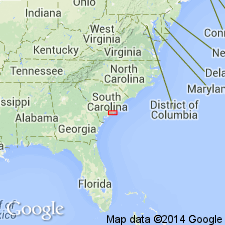
- Usage in publication:
-
- Cane Acre Formation*
- Modifications:
-
- Original reference
- Biostratigraphic dating
- Dominant lithology:
-
- Clay
- Sand
- Silt
- AAPG geologic province:
-
- Atlantic Coast basin
Summary:
Pg. 11 (fig. 8), 22-23, 31 (fig. 22), 34-35. Cane Acre Formation of Black Creek Group. Occurs in subsurface of southern Dorchester County, southeastern South Carolina. Sediments previously included in the Black Creek Formation by Hazel and others (1977) and Gohn and others (1977). Consists of an upper sand member and a lower clay-silt member. Thickness 200 feet at type. Is basal formation of Black Creek Group. Overlies Caddin Formation (new); underlies Coachman Formation (new) of Black Creek Group. Fossils. Age is Late Cretaceous (middle Campanian; Tayloran Provincial Age; GLOBOTRUNCANITA ELEVATA planktic foram zone, CALCULITES OVALIS to CERATOLITHOIDES ACULEUS (NC18 to NC19) calcareous nannofossil zone, ASCETOLEBERIS PLUMMERI ostracode zone).
Type section (subsurface): depth-interval 1,344 to 1,544 ft, Clubhouse Crossroads No. 1 drill core, near Clubhouse Crossroads, Dorchester Co., southeastern SC. Named from Cane Acre Road, along which drill site is located.
Source: Publication.
For more information, please contact Nancy Stamm, Geologic Names Committee Secretary.
Asterisk (*) indicates published by U.S. Geological Survey authors.
"No current usage" (†) implies that a name has been abandoned or has fallen into disuse. Former usage and, if known, replacement name given in parentheses ( ).
Slash (/) indicates name conflicts with nomenclatural guidelines (CSN, 1933; ACSN, 1961, 1970; NACSN, 1983, 2005, 2021). May be explained within brackets ([ ]).

